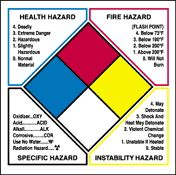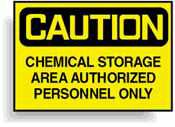 |
 |
| MSDS Topics |
Free Sites | FAQ's | Regulations | Glossary | Software | Suppliers |
| Books | Forum | Poll | Fun stuff | Quiz | Store | |
| MSDS and safety supplies | Search ALL our MSDS info | |||||
 | |||
 |
 |
 |
|
| Title: 11/10/1992 - Employee "Right to Know" chemical labeling. | |
| Record Type: Interpretation | Standard Number: 1910.1200 |
November 10, 1992
The Honorable Thomas J. Bliley, Jr.
U.S. House of Representatives
Washington, D.C. 20515
Dear Congressman Bliley:
This is in response to your letter of September 2, on behalf of your constituent Mr. N. Lee Brown, concerning the Occupational Safety and Health Administration's (OSHA) Hazard Communication Standard (HCS), 29 CFR 1910.1200. Mr. Brown pointed out what seemed to be discrepancies in describing the hazards of the chemical acetaldehyde.
|
The Hazard Communication Standard requires chemical manufacturers or importers to consider a chemical carcinogenic if the International Agency for Research on Cancer (IARC), National Toxicology Program (NTP) or OSHA designates the chemical as a carcinogen or potential carcinogen (please see 29 CFR 1910.1200(d)(4)). If the chemical is a carcinogen and in concentrations of 0.1% or more the health hazard must be explained in the material safety data sheet (MSDS). We see no conflicting information, since the document which Mr. Brown enclosed stated that both NTP and IARC classify acetaldehyde as a carcinogen. Mr. Brown also noted that the Food and Drug Administration (FDA) recognizes acetaldehyde as safe "for use as a flavoring," and that this conflicting information makes a judgment call difficult. When there is conflicting information that would affect employee safety and health, employers should take the more conservative approach to ensure that the work place is hazard free. In this case, however, OSHA gives solid guidance in its Hazard Communication Standard on which chemicals to label carcinogenic. FDA classification is not required by the HCS; however, if Mr. Brown is interested in the FDA's studies we suggest that he contact the FDA to request their studies on the health effects of acetaldehyde as a flavoring and preservative in consumer products.
|  Communicate workplace hazards with handy labels from Safety Emporium. |
Sincerely,
Roger A. Clark,
Director
Directorate of Compliance Programs
September 2, 1992
Secretary Lynn Martin
Department of Labor
200 Constitution Avenue, NW
Washington, D.C. 20210
Dear Secretary Martin:
A constituent brought to my attention his peculiar difficulty in attempting to comply with OSHA "Right to Know" regulations. Enclosed you will find a copy of his complaint and my response.
His frustrations with current methods of chemical hazards classifications seem to illustrate a larger need for reform. I urge you to investigate this matter and respond at your earliest convenience. Thank you.
Sincerely,
Thomas J. Bliley, Jr.
Member of Congress
Enclosure
July 28, 1992
The Honorable Thomas J. Bliley, Jr.
4914 Fitzhugh Avenue
Richmond, Virginia 23230
Dear Tom:
In compliance with OSHA "Right to Know" regulations we review the work place hazards of chemicals used at our facilities.
Attached are meting notes used to describe the hazards of the chemical acetaldehyde. These notes point out the confusion that exists in specifying hazards under our Nation's current chemical hazards management system.
 Encourage proper work habits with safety signs, labels and training from Safety Emporium. |
As our employees learn from page three of the guideline, acetaldehyde may be:
|
In short, a difficult judgement for the employee or management to make. I encourage you and the Congress to seek out common methods and policies for use in determining such critical definition to our employees and to the procedure management uses to insure the health of its workers.
Yours truly,
N. Lee Brown
Director Fibers Engineering
The official, public domain, OSHA version of this document is available at http://www.osha.gov/pls/oshaweb/owadisp.show_document?p_table=INTERPRETATIONS&p_id=20929&p_text_version=FALSE